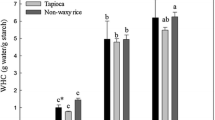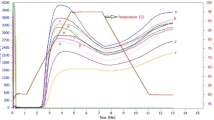Abstract
Effect of NaOH treatment on granular hydrolysis of cereal starches was studied and granular starch hydrolyzing enzyme is used to hydrolyze native and NaOH-treated starch for 24 h. The dextrose equivalent value of NaOH-treated starch increased significantly compared to native starch, i.e., 28–38 % for corn, 7–37 % for rice, but no significant increase for corn starch. Scanning electron microscopy micrographs showed that NaOH treatment caused an enlargement of pores and degrades the surface of starch granules. Hydrolyzed-treated starch exhibited rougher surface and more porous granules compared to native starch. The swelling power and pasting properties of NaOH-treated starches were markedly altered after hydrolysis. X-ray pattern of all starches showed no changes and the amylose content decrease significantly after hydrolysis, which could due to extensive degradation of amorphous region. Evidently, NaOH treatment below gelatinization temperature was effective in enhancing the degree of granular starch hydrolysis.




Similar content being viewed by others
References
Zhang T, Oates CG (1999) Relationship between α-amylase degradation and physico-chemical properties of sweet potato starches. Food Chem 65:157–163
Morrison WR (1981) Starch-lipids: a reappraisal. Starch-Starke 33:408–410
Hoover R, Manuel H (1996) The effect of heat-moisture treatment on the structure and physicochemical properties of normal maize, waxy maize, dull waxy maize and amylomaize V starches. J Cereal Sci 23:153–162
Vasanthan T, Sosulski FW, Hoover R (1995) The reactivity of native and autoclaved starches from different origins towards acetylation and cationization. Starch 4:135–143
Guilbot, A. and Mercier, C. (1985). Starch. In: The Polysaccharides. USA: Academic Press. Vol 3. pp. 256–261
Oates CG (1997) Towards an understanding of starch granule structure and hydrolysis. Food Sci Technol 8:375–382
Vasanthan T, Hoover R (1992) Effect of defatting on starch structure and physicochemical properties. Food Chem 45:337–347
Leloup VM, Colonna P, Buleon A (1991) Influence of amylose-amylopectin ratio on gel properties. J Cereal Sci 16:253–266
Mistry AH, Eckhoff AR (1992) Characteristics of alkali-extracted starch obtained from corn flour. Cereal Chem 69:296–303
Medcalf DG, Gilles KA (1966) Effect of a lyotropic on series on the pasting characteristics of wheat and corn starches. Starch-Starke 18:101–105
Lamsal BP, Wang H, Johnson LA (2011) Effect of corn preparation methods on dry-grind ethanol production by granular starch hydrolysis and partitioning of spent beer solids. Bioresour Technol, in press
Wang P, Singh V, Xue H, Johnston DB, Rausch KD, Tumbleson ME (2006) Comparison of raw starch hydrolyzing enzyme with conventional liquefaction and saccharification enzymes in dry-grind corn processing. Cereal Chem 84:10–14
Liukkonen KH, Montfoort A, Laakso SV (1992) Water-induced lipid changes in oat processing. J Agric Food Chem 40:126–130
Wang L, Wang YJ (2001) Structures and physicochemical properties of acid- thinned corn, potato and rice starches. Starch-Starke 53:570–576
Miller GL (1959) Use of dinitrosalicylic acid reagent for determination of reducing sugar. Anal Chem 31:426–428
Lauro M, Forssell PM, Suortti MT, Hulleman SHD, Poutanen KS (1999) α-amylolysis of large barley starch granules. Cereal Chem 76(6):925–930
McGrance SJ, Cornell HJ, Rix CJ (1998) A simple and rapid colorimetric method for the determination of amylose in starch products. Starch-Starke 50:158–163
Schoch TJ (1964) Swelling power and solubility of granular starches. In: Whistler RL (ed) Methods in carbohydrate chemistry, vol. 4. Academic Press, London
Wootton M, Ho P, Kensington NSW (1989) Alkali gelatinization of wheat starch. Starch-Starke 41:261–265
Han XZ, Hamaker BR (2002) Association of starch granule proteins with starch ghost and remnants revealed by confocal laser scanning microscopy. Cereal Chem 79:892–896
French D (1984) Organization of starch granules. In: Whistler RL, BeMiller JN, Paschall EF (eds) Starch: Chemistry and technology. Academic Press, Inc, USA, pp 184–247
Chen J, Jane J (1994) Properties of granular cold-water-soluble starches prepared by alcoholic-alkaline treatments. Cereal Chem 71(6):623–626
Wang YJ, Wang L (2003) Physicochemical properties of common and waxy corn starches oxidized by different levels of sodium hypochlorite. Carbohydr Polym 52:207–217
Fannon JE, Hauber RJ, BeMiller JN (1992) Surface pores of starch granules. Cereal Chem 69(3):284–288
Fannon JE, Shull JM, BeMiller JN (1993) Interior channels of starch granules. Cereal Chem 70(5):611–613
Helbert W, Schulein M, Henrissat B (1996) Electron microscopic investigation of the diffusion of Bacillus licheniformis alpha-amylase into corn starch granules. Int J Biol Macromol 19:165–169
Tester RF, Morrison WR (1990) Swelling and gelatinization of cereal starches. I. Effects of amylopectin, amylose, and lipid. Cereal Chem 67:551–557
Morrison WR, Tester RF, Snape CE, Law R, Gidley MJ (1993) Swelling and gelatinization of cereal starches. IV. Some effects of lipid-complexed amylose and free amylose in waxy and normal barley starches. Cereal Chem 70:385–391
Hamaker BR, Griffin VK (1993) Effect of disulfide bond-containing protein on rice starch gelatinization and pasting. Cereal Chem 70:377–380
Ragheb AA, El-Thalouth IA, Tawfik S (1995) Gelatinization of starch in aqueous alkaline solutions. Starch-Starke 46:338–345
Meyer KH, Bernfeld P, Boissonnas RA, Gurtler P, Noelting G (1949) Starch solutions and pastes and their molecular interpretation. J Phys Chem 53:319–334
Beta T, Corke H, Taylor JRN, Rooney LW (2001) Effect of steeping treatment on pasting and thermal properties of sorghum starches. Cereal Chem 78(3):303–306
Ganz AJ (1965) Effect of sodium chloride on the pasting of wheat starch granules. Cereal Chem 42:429–431
Author information
Authors and Affiliations
Corresponding author
Rights and permissions
About this article
Cite this article
Uthumporn, U., Shariffa, Y.N., Fazilah, A. et al. Effects of NaOH treatment of cereal starch granules on the extent of granular starch hydrolysis. Colloid Polym Sci 290, 1481–1491 (2012). https://doi.org/10.1007/s00396-012-2674-2
Received:
Revised:
Accepted:
Published:
Issue Date:
DOI: https://doi.org/10.1007/s00396-012-2674-2




